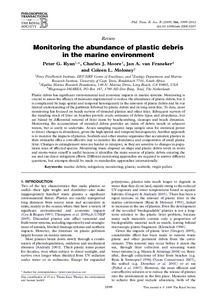Monitoring the abundance of plastic debris in the marine environment.

View/
Average rating
votes
Date
2009Author
Ryan, Peter G.
Moore, Charles J.
Franeke, Jan A. van
Moloney, Coleen L.
Metadata
Show full item recordAbstract
Plastic debris has significant environmental and economic impacts in marine systems. Monitoring is
crucial to assess the efficacy of measures implemented to reduce the abundance of plastic debris, but it
is complicated by large spatial and temporal heterogeneity in the amounts of plastic debris and by our
limited understanding of the pathways followed by plastic debris and its long-term fate. To date, most
monitoring has focused on beach surveys of stranded plastics and other litter. Infrequent surveys of
the standing stock of litter on beaches provide crude estimates of debris types and abundance, but
are biased by differential removal of litter items by beachcombing, cleanups and beach dynamics.
Monitoring the accumulation of stranded debris provides an index of debris trends in adjacent
waters, but is costly to undertake. At-sea sampling requires large sample sizes for statistical power
to detect changes in abundance, given the high spatial and temporal heterogeneity. Anoth.....
Journal
Philosphical Transactions of the Royal Society BVolume
364Page Range
pp.1999–2012Document Language
enSustainable Development Goals (SDG)
14Best Practice Type
Manual (incl. handbook, guide, cookbook etc)Standard Operating Procedure
DOI Original
10.1098/rstb.2008.0207Citation
Ryan, P.G.; Moore, C.J.; van Franeker, J.A. and Moloney, C.L. (2009) Monitoring the abundance of plastic debris in the marine environment. Philosophical Transactions of the Royal Society, B, 364, pp.1999–2012. DOI::10.1098/rstb.2008.0207Collections
- EC-OBPSS Practices [141]
- Miscellaneous Community Practices [541]
 Repository of community practices in Ocean Research, Applications and Data/Information Management
Repository of community practices in Ocean Research, Applications and Data/Information Management